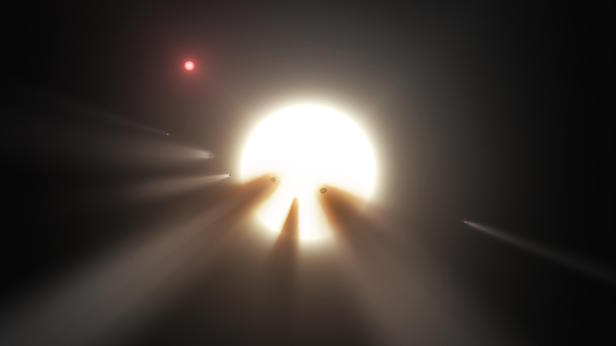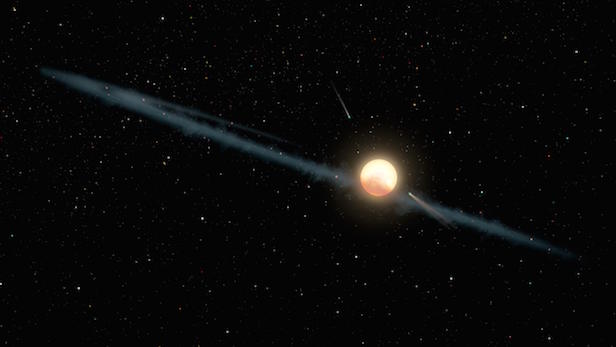Mysterious ‘alien megastructure star’ could be caused by dust
Tabby’s Star has baffled astronomers for years, as it shows completely unexpected light variation

Comets could be the origin of the dust surrounding Tabby’s Star. Image credit: NASA/JPL-Caltech
The famously puzzling Tabby’s Star, also known as Boyajian’s Star or KIC 8462852, exhibits unusual changes in its brightness and astronomers still struggle to explain it. A new study that examines the star in infrared, visible and ultraviolet suggests that these long-term changes in brightness are due to the interference of an uneven circumstellar dust disc.
NASA’s Kepler observed the unusual Tabby’s Star, and it showed dimming of up to 20 per cent over a matter of days. Over a long-term period, the star has also showed much more subtle dimming trends, but scientists have only been able to speculate as to the cause of this. One theory is that the star consumed a planet, making it unstable. The other, more imaginative, explanation is that a advanced civilization have encased the star with a ‘megastructure’, absorbing its energy and creating the decrease in brightness.
Using a combination of NASA’s Spitzer and Swift missions, as well as the Belgian AstroLAB IRIS observatory, which respectively observed the star in infrared, ultraviolet and visible light. Scientists have suggested that this long-term dimming is most likely to an uneven dust cloud travelling around the star. This is because the researchers noticed that there was less dimming in infrared than in ultraviolet, and any object larger than a dust particle would cause an equal dimming effect.

The hypothetical disc of dust surrounding Tabby’ Star would be unevenly distributed to explain the unpredictability in the light variation. Image credit: NASA/JPL-Caltech
“This pretty much rules out the alien megastructure theory, as that could not explain the wavelength-dependent dimming,” says Huan Meng, at the University of Arizona, Tucson. “We suspect, instead, there is a cloud of dust orbiting the star with a roughly 700-day orbital period.”
Citizen scientists made a vital contribution in this study, as the Planet Hunters project first identified the object as “bizarre” and “interesting” as they went through the public access Kepler data. This then led to the further study in 2016 that formally introduced the object. The most recent study also included valuable work by amateur astronomers that provided technical and software support to AstroLAB.
As for further study, researchers have outlined the need to address the peculiarity of the short-term light variation, especially what happened in a three-day surge in 2017. They also did not address the mystery of the 20 per cent variation of light, but previous research suggested a swarm of comets might be the cause. As comets are the most common source of dust in the universe, this could link to the long-period dimming studied by Meng and the rest of the team.
Keep up to date with the latest reviews in All About Space – available every month for just £4.99. Alternatively you can subscribe here for a fraction of the price!




